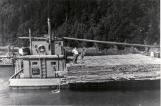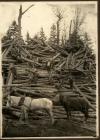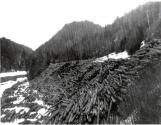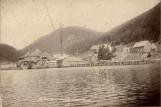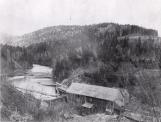6
The logs would then be piled up in large ‘brows' which often covered the entire side of a hill.8
During the spring freshets these logs would be ‘river drove', or floated, down the river to large millponds at the mouth of the river.9
This photo shows a log jam at the mouth of the Point Wolfe River.19 September 1915
Point Wolfe, New Brunswick, Canada

10
This photo shows a log jam at the Point Wolfe Dam.19 September 1915
Point Wolfe, New Brunswick, Canada
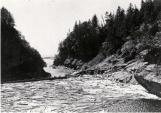
11
An unidentified man using a 'Pike Pole' to push logs in a log boom on the Alma river.19 September 1915
Alma, New Brunswick, Canada
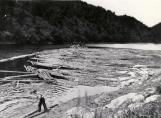
13
In the spring when the water level at the dams up stream had reached a certain level the gates would be hoisted and a wall of water would rush down the river collecting the logs already in the river and hurdling them down stream towards the mill. Men along the river banks would work feverishly to make sure that all the logs piled up in ‘brows' along the river were pushed into the river before the rushing water subsided. This was a very dangerous time, and watch men along the river would yell to the people down river "Dam Water" when the dam waters began to rush. Those who did not hear the cry would soon hear a great roar as a wall of logs and water rushed down stream. Large sawmills at the mouth of the river would then saw the logs into lumber and often load the lumber directly onto sailing schooners docked at the mill.14
A group of workmen standing on the wharf at Point Wolfe.19 September 1915
Point Wolfe, New Brunswick, Canada
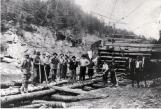
15
If that was not possible smaller ships called scows would transport the lumber from the mill to ships waiting to be loaded out in the Bay.16
'The Manning' hauling a load of lumber from the wharf at Point Wolfe to a ship out in the Bay.19 September 1915
Point Wolfe, New Brunswick, Canada
